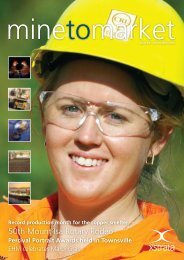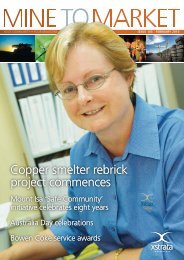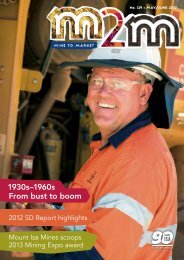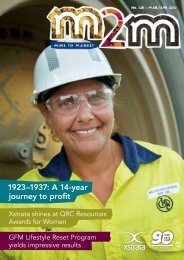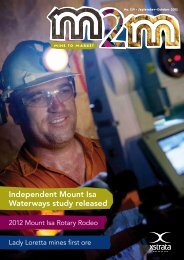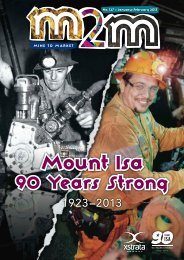Xstrata Copper North Queensland.pdf - Mount Isa Mines
Xstrata Copper North Queensland.pdf - Mount Isa Mines
Xstrata Copper North Queensland.pdf - Mount Isa Mines
You also want an ePaper? Increase the reach of your titles
YUMPU automatically turns print PDFs into web optimized ePapers that Google loves.
Environmental performance<br />
Energy<br />
In 2010, the <strong>Mount</strong> <strong>Isa</strong> <strong>Mines</strong> copper<br />
operations had a total energy consumption<br />
of 5.1 petajoules (PJ) compared to 5.3 PJ in<br />
2009. This decrease was primarily due to<br />
reduced consumption of natural gas and coal.<br />
Energy intensity remained stable in 2010 at<br />
24 gigajoules (GJ) per tonne of contained<br />
metal, the same result we reported in 2009.<br />
Water management<br />
Fresh water supply and use<br />
Fresh water consumed at the <strong>Mount</strong> <strong>Isa</strong><br />
<strong>Mines</strong> copper operations is sourced from<br />
Lake Moondarra and Lake Julius. These two<br />
dams are used in combination to ensure fresh<br />
water supply to <strong>Mount</strong> <strong>Isa</strong> <strong>Mines</strong> as well as<br />
the <strong>Mount</strong> <strong>Isa</strong> community. Lake Moondarra<br />
reached 87% capacity in March 2010 and<br />
Lake Julius reached 100% in February 2010.<br />
Of the fresh water consumed in 2010, 100%<br />
was sourced from Lake Moondarra. In 2010,<br />
a total of 4,670 ML of fresh water was<br />
consumed by the <strong>Mount</strong> <strong>Isa</strong> <strong>Mines</strong> copper<br />
operations, including mining, processing<br />
and smelting operations. The water intensity<br />
figure for 2010 was 21.75 kilolitres per tonne<br />
of contained metal.<br />
Surface water<br />
Surface water in the <strong>Mount</strong> <strong>Isa</strong> <strong>Mines</strong> region<br />
flows into the Leichhardt River and then into<br />
Lake Moondarra approximately 15 kilometres<br />
downstream of the major site operations.<br />
Water discharged off site is sampled and<br />
analysed; and results have been provided to<br />
the Department of Environment and Resource<br />
Management.<br />
In 2010, approximately $4 million was spent<br />
on installing a new tailings reclamation line,<br />
enabling water that would otherwise be<br />
lost to evaporation in the tailings dams, to<br />
be reused as process water on site. Refer to<br />
case study on page 95 for more information.<br />
Other improvements to water management<br />
systems on site during 2010 have included<br />
cleaning out antipollution ponds, relining<br />
drains, and increasing stormwater<br />
pumping capabilities.<br />
Significant improvements have been made<br />
across site over the past few years in order to<br />
maximise reuse of stormwater in the process<br />
water circuits. In particular, we have focused<br />
on improving stormwater management<br />
in areas associated with potential off-site<br />
discharge points. In 2010, the final stage of<br />
the Death Adder Gully (DAG) improvements<br />
was completed, including installation of a<br />
pumping system to enable water at the DAG<br />
weir to be pumped back into Barracks Dam,<br />
which forms part of the site-wide water<br />
management strategy.<br />
Biodiversity<br />
The <strong>Mount</strong> <strong>Isa</strong> <strong>Mines</strong> copper operations<br />
manage approximately 30,000 hectares (ha)<br />
of land on mining lease ML8058, for the<br />
copper and zinc businesses, within the <strong>Mount</strong><br />
<strong>Isa</strong> Inlier bioregion and Australia’s tropical<br />
savannas. ML8058 is characterised by rugged,<br />
rocky hills and poor shallow soil. Low open<br />
woodland with Eucalyptus, Corymbia and<br />
Acacia species predominates, with a ground<br />
layer of Triodia species (Spinifex) which<br />
reflects the complex geology, infertile soil and<br />
semi-arid climate.<br />
In 2010, 11 ha of land was disturbed by<br />
our <strong>Mount</strong> <strong>Isa</strong> <strong>Mines</strong> copper operations<br />
(see table below) for the construction<br />
of infrastructure and to support mine<br />
development. Opportunity for rehabilitation<br />
on ML8058 is limited because most areas<br />
currently disturbed are considered ‘active’ and<br />
are not available for rehabilitation. Numerous<br />
rehabilitation studies were progressed in<br />
2010 to develop best practice rehabilitation<br />
techniques specifically tailored to the<br />
local environment.<br />
During the year we continued biodiversity<br />
management planning comprising various<br />
projects and internal systems updates with<br />
outcomes from the ML8058 biodiversity<br />
study, which was finalised early in the year.<br />
Effects on local environment<br />
As part of the biodiversity management<br />
planning in 2010, recommendations from<br />
the ML8058 biodiversity study were<br />
developed and will remain ongoing in 2011.<br />
Biodiversity projects targeted key threatening<br />
processes for biodiversity on the lease and<br />
included development of a fire management<br />
plan, and a pest management plan. No<br />
known effects were identified on the Red<br />
Goshawk, which is listed as ‘vulnerable’<br />
under national legislation and International<br />
Union for Conservation of Nature (IUCN)<br />
Red List. During 2010, areas of conservation<br />
significance were managed by existing land<br />
management systems. No disturbed areas<br />
were identified during the biodiversity study<br />
as being of conservation significance.<br />
Management of sulphur dioxide (SO 2 )<br />
emissions forms part of the biodiversity<br />
strategy as SO 2 fallout from the smelters<br />
can have a localised impact on vegetation.<br />
The introduction of the acid plant in 2000,<br />
owned and operated by Incitec Pivot,<br />
reduced SO 2 emissions from the copper<br />
smelter by 78% during 2010.<br />
Habitats protected or restored<br />
The conservation significance of ML8058<br />
has been interpreted with respect to the<br />
surrounding landscape, the conservation<br />
status of the species present and the<br />
potential and actual threats operating on<br />
the lease. Our copper operations are within<br />
a traditionally grazed area and confined to<br />
a minimal footprint. However there were<br />
some habitats identified during the 2009<br />
biodiversity study which are deemed to be<br />
of conservation significance.<br />
A Conservation Management Plan was<br />
developed in 2009 based on the outcomes<br />
of the study in relation to these regional<br />
ecosystems, and the plan was finalised and<br />
communicated to key stakeholders early<br />
in 2010.<br />
Following the vegetation survey conducted<br />
as part of the biodiversity study, seeds were<br />
collected from a community of Eucalyptus<br />
nudicaulis trees. The conservation status<br />
of this species is being reviewed and<br />
may be classified as vulnerable. Seeds<br />
were propagated and distributed into the<br />
community during various environment<br />
events such as World Environment Day and<br />
Green Week.<br />
During 2010 there were no instances of<br />
stormwater discharging off site from copper<br />
mining or processing areas at the <strong>Mount</strong> <strong>Isa</strong><br />
<strong>Mines</strong> site.<br />
Land disturbed (ha) – <strong>Mount</strong> <strong>Isa</strong> <strong>Mines</strong> copper operations<br />
2009 2010<br />
Rehabilitation during the year 0 0<br />
Total rehabilitation completed to date 0 0<br />
Area disturbed during the year 23 11<br />
Total area disturbed 1,494 1,505<br />
Sustainability Report 2010 89



